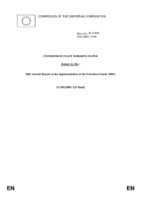| dc.description.abstract | The year 2004 was marked by four important events: allocation of the performance reserve, followed by the mid-term review of the programmes in the EU-15, EU enlargement and the start of negotiations on the regulatory framework for the 2007-2013 programmes on the basis of the Commission proposal. Allocation of the performance reserve, which was put into effect in 2004, is an innovation introduced in the 2000-2006 programming period. It is governed by Article 44 of Regulation (EC) No 1260/1999, which stipulates that 4% of the initial resources should be held back for allocation at mid-term to programmes performing the best. The Commission report concluded that the reserve acted as an incentive for capacity building and better management practices across the Member States, despite different methods used for assessing performance and making allocation proposals. Article 14 of Regulation 1260/1999 lays down that the programmes can be adapted following the mid-term evaluation and allocation of the performance reserve. In consequence, most of 2004 was devoted to the discussions on the mid-term review of the programmes in the EU-15. It provided an opportunity for many Member States to take into account the priorities identified in the Lisbon and Gothenburg Strategies and earlier Commission recommendations in that respect. Preliminary analysis shows that Member States have recognised the importance of the Lisbon and Gothenburg priorities in many amended programmes. The enlargement of the EU resulted in the inclusion of, on the whole, less developed regions in the EU. Over 92% of the population in the new Member States live in regions with a GDP per head of under 75% of the EU-25 average and 61% live in the areas below 50%. The European Union will assist the new Member States to reduce these disparities. In total, EUR 24 billion of Community aid (at current prices) is allocated to the EU-10 for the 2004-06 programmes. Of the EUR 14.96 billion from the Structural Funds, 61% will be from the ERDF, 25% from the ESF, 12% from the EAGGF-guidance section and about 2% from the FIFG. Although their Community Support Frameworks and Single Programming Documents were not been formally approved until the effective date of accession (i.e. 1 May 2004), the new Member States had the possibility of committing Structural Funds money from 1 January 2004 provided that selected projects complied with the relevant Community legislation. In July 2004, the Commission adopted a legislative proposal for the new cohesion policy post-2006. This proposal includes key ideas formulated in the debates launched by the Commission at the beginning of 2004 with the publication of the Third Report on Economic and Social Cohesion;1 these debates continued around Europe throughout the year (e.g. the Third Cohesion Forum organised in Brussels in May, Seminar “Open days” in September, etc.). The legislative package includes a 1 COM (2004)107
EN 4 ENproposal for a general regulation, a regulation for each financial source (ERDF, ESF and Cohesion Fund) and a new proposal for cross-border cooperation. For the 2007-2013 period, the Commission proposes to allocate EUR 336.1 billion to three priorities: A “Convergence objective” is proposed for the regions with a GDP below 75% of the EU average and the outermost regions, phasing out support for the regions affected by the ‘statistical effect’ of enlargement2 and the Member States eligible for the Cohesion Fund (EUR 264 billion or 78.5% of the total contributions from the Funds). A “Regional competitiveness and employment objective” will target all regions not be covered by the Convergence objective to improve their competitiveness and promote labour market policies in line with the European Employment Strategy and the Lisbon strategy (EUR 57.9 billion or 17.22% of the total allocation from the Funds). The “European territorial cooperation objective” will aim to facilitate cross-border and trans-national cooperation and exchange of experience (EUR 13.2 billion or 3.94% of the total). |

